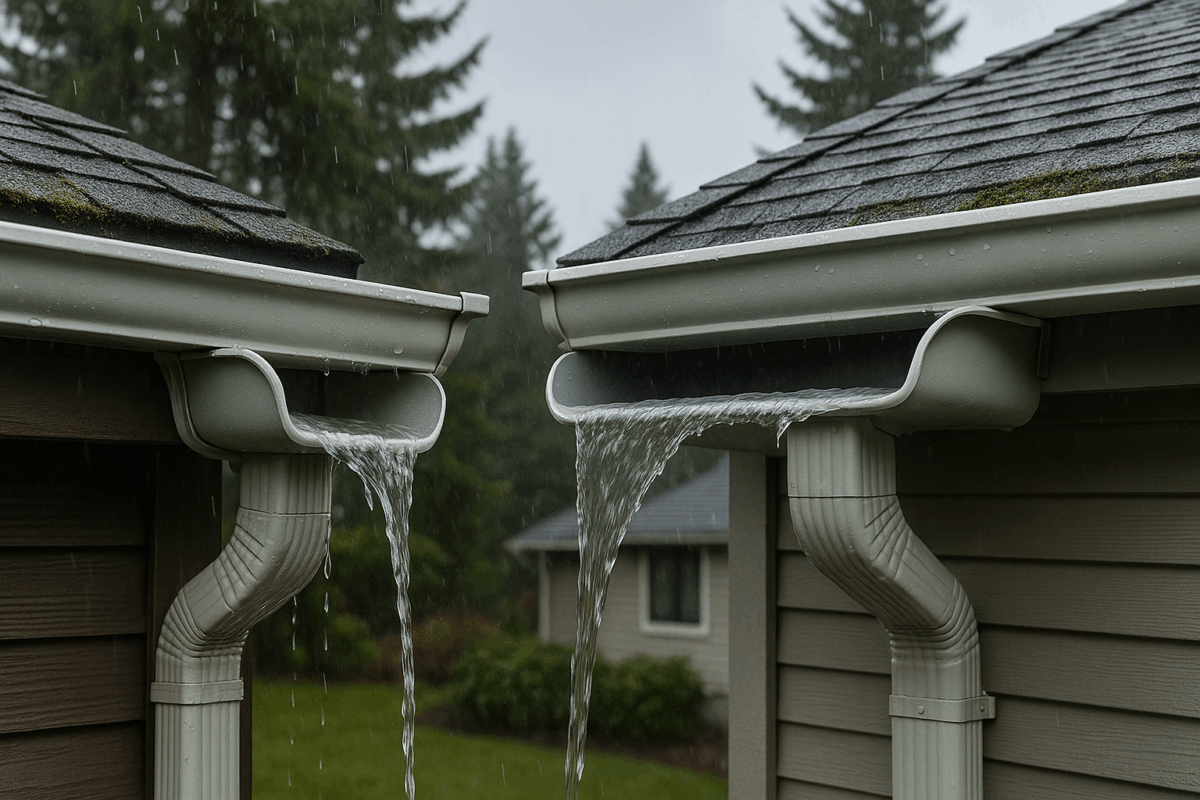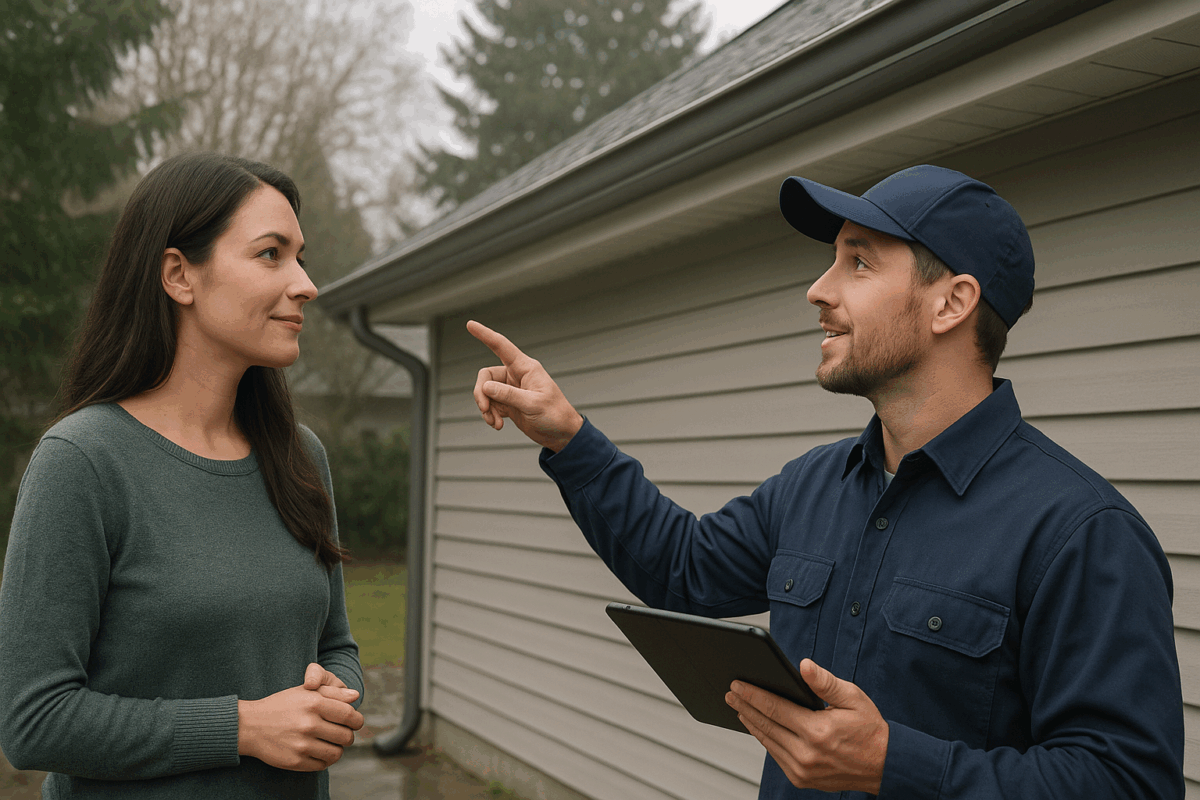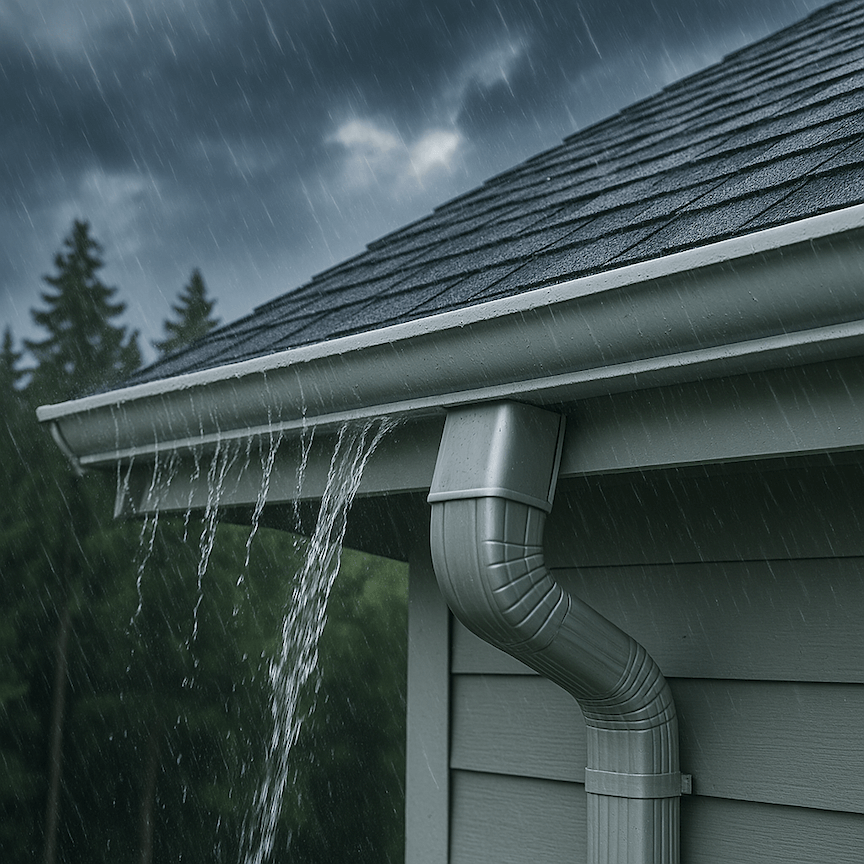Washington has a reputation for rain, but how it behaves across the state is what really sets the stage for this conversation. The long wet seasons, the sudden cloudbursts, and the steep roofs you see in so many neighborhoods all play into how well a gutter system handles water.
Many people stick with the standard 5-inch size because that is what their home came with. But the truth is, gutter size makes a huge difference in a climate where water shows up for months at a time.
This blog takes a closer look at how 5-inch and 6-inch gutters work, why the difference matters in Washington, and when upsizing becomes a smart move rather than just an upgrade.
How Washington Weather Shapes the Way Gutters Perform
Rain shows up differently depending on where you live in the state. Western Washington usually gets around 37 inches of rain every year, often stretched across months of steady drizzle and surprise downpours. Meanwhile, areas east of the Cascades get far less, but storms can be intense when they roll in.
Those patterns matter because gutters are not just decorative trim. They are a drainage system. When you have a long wet season, that system gets used constantly. When you have steep roof pitches, common in the PNW to help shed moisture, water hits the gutters with speed. When a roof collects debris from tall evergreens, clogs show up faster than people expect.
All of this means homeowners need gutter systems that can carry water away before it spills over the sides and starts creeping into the foundation or soaking the siding. It also explains why seamless gutters have become so common across the region. With fewer joints, they stay cleaner, drain better, and hold up against weeks of moisture without leaking at the seams.
How Roof Pitch, Size, and Storm Intensity Influence Gutter Sizing
Gutter size is calculated from a few basic factors. The first is the roof drainage area, the amount of surface sending water into each section of the gutter. A bigger roof plane means a bigger stream of water. The second is roof pitch. A steep roof collects rainwater more quickly and channels it downward with greater force. The last piece is storm intensity, which has become increasingly unpredictable.
Together, these factors explain why a gutter that seems “fine” during a light shower suddenly overflows during a heavier storm. Once a gutter reaches its capacity, water has nowhere to go except over the edge. That’s when you start seeing peeling paint, puddles around the foundation, or rot near the fascia.
This is also where proper gutter installation and correctly sized downspouts come into the picture. You can have the right gutter width but the wrong downspout size, and the system still backs up. If you notice water overflowing during a storm, you might think about downspout repair services near you, but sizing is often the real problem, not a broken downspout.
What Really Separates 5-Inch and 6-Inch Gutters
Most homes in the U.S. come with 5-inch K-style gutters. They work well in areas with moderate rainfall. But a 6-inch K-style gutter can carry about 65–70% more water per linear foot, and that difference matters when storms get intense.
A few practical differences stand out:
- Water volume: A 6-inch gutter can handle larger roof planes or steeper pitches without overflowing during heavy rain.
- Downspout size: Most 5-inch gutters use 2×3 downspouts, while 6-inch systems typically use 3×4 downspouts. The larger downspout clears water faster and reduces clogging.
- Debris tolerance: Larger openings mean leaves, needles, and moss are less likely to get stuck, which is another big factor in the Pacific Northwest.
- Home style compatibility: Bigger roofs, tall multilevel homes, and structures with multiple valleys almost always benefit from a wider gutter.
Why Many Washington Homes Benefit From Switching to 6-Inch Seamless Gutters
Some homes genuinely do fine with 5-inch gutters. Smaller ramblers, simple roof layouts, and houses in lower-rainfall regions often manage without issues. But many Washington homes fall into the opposite category.
Think of big Craftsman roofs with wide overhangs, or modern builds with long, steep pitches. These roofs shed a lot of water at once. Add in debris from pines, firs, or maples, and the system must work even harder.
That’s where 6-inch seamless gutters shine. The extra capacity helps prevent the sudden waterfalls you see during a storm. Homeowners also notice fewer erosion marks near downspouts and less moisture creeping into crawlspaces. And during the heaviest winter storms, the wider gutter stays far more stable.
Here are situations where 6-inch gutters make a big difference:
- A large roof area draining into a single run
- Steep roof pitches that push water quickly
- Homes surrounded by tall evergreens
- Properties with past foundation or siding moisture issues
- Roof valleys that collect and funnel water into one spot
Think About Cost, Repairs, and Long-Term Value Before Choosing Your Gutter Size
Most people expect 6-inch gutters to be a major price jump, but national cost guides say otherwise. Aluminum K-style gutters typically cost $6–$12 per linear foot, while many seamless 6-inch aluminum systems cost $7–$15 per foot, depending on the market and roof complexity. That gap looks small compared to moisture damage.
Fascia board replacement often runs $5–$12 per linear foot, which can easily reach $500–$2,000+ on a typical home. Foundation or serious siding repairs from chronic overflow can climb into the $2,000–$6,000 range or higher.
Sizing correctly during gutter replacement cuts down future hassles. When gutters are too small, they overflow more often and usually require extra gutter repair, especially once storms hit harder and debris piles up.
Protect Your Washington Home With the Right Gutter System
Choosing between 5-inch and 6-inch gutters affects how well your home handles rain, storms, and debris for years. The right gutter size helps prevent overflow, protects the foundation, and keeps your siding dry during long wet seasons.
When you pair a smart size choice with seamless aluminum gutter installation, you end up with a system designed for real Washington weather, not just average conditions.
If you want help protecting your home from water damage, contact us at (971) 777-9899 or get a free estimate here. Or you can reach out to our team at Gutter Empire LLC to evaluate your roof, measure your drainage needs, and recommend the best solution for long-term performance.
Key Takeaways
- Washington’s long wet seasons and sudden heavy storms push gutter systems to their limits, making gutter size a major performance factor.
- 6-inch gutters can handle 65–70% more water, reducing overflow during intense rainfall.
- Roof pitch, roof size, and debris from evergreens increase the need for larger gutter capacity in many Washington homes.
- Larger 3×4 downspouts used with 6-inch gutters improve drainage and reduce clogging issues.
- Seamless aluminum gutters offer better durability and fewer leak points than standard sectional systems.
- Upsizing gutters can help prevent foundation erosion, siding moisture problems, and fascia damage.
- The cost difference between 5-inch and 6-inch gutters is often small compared to potential water damage repair expenses.
- Homes with steep roofs, large surface areas, valleys, or heavy tree debris benefit most from 6-inch seamless gutters.
Citations
- Washington climate and rainfall patterns influence gutter performance. Source: Washington State Department of Commerce – Climate & Geography – https://choosewashingtonstate.com/research-resources/about-washington/climate-geography/




